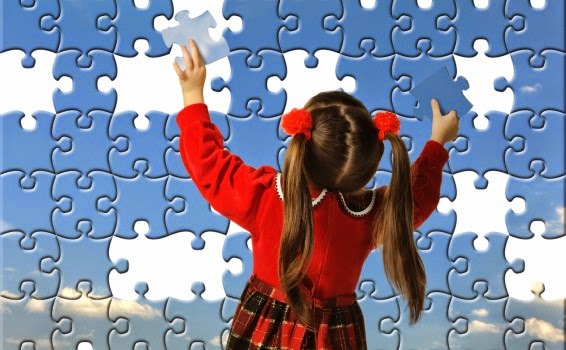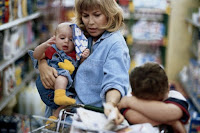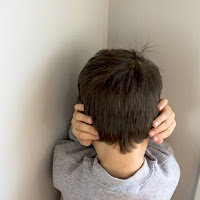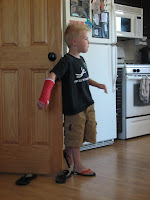"Any tips for dealing with a very fragile and overly sensitive child on the autism spectrum ...he's a chronic worrier to say the least and will go back and forth between being extremely shy or very aggressive?"
As some parents may have discovered, many young people with Asperger’s (AS) and High Functioning Autism (HFA) are “emotionally fragile” (to coin a term). In other words, these individuals have great difficulty coping with day-to-day stressors, and exhibit unusually withdrawn or aggressive behaviors as a defense mechanism.
As some parents may have discovered, many young people with Asperger’s (AS) and High Functioning Autism (HFA) are “emotionally fragile” (to coin a term). In other words, these individuals have great difficulty coping with day-to-day stressors, and exhibit unusually withdrawn or aggressive behaviors as a defense mechanism.
Emotional fragility is most prevalent in school-age AS and HFA kids. It can manifest itself in many ways, all of which are challenging for the youngster, parents, and teachers. These young people often exhibit a variety of symptoms that cause school psychologists to misdiagnose them with depression, bipolar disorder, or some other disorder. A wrong diagnosis can often lead to the youngster being placed in inappropriate special education classes, or even being treated with the wrong medication.
Traits of Emotional Fragility —
1. An emotionally fragile AS or HFA youngster may become socially anxious and withdrawn in public. When faced with risks or decisions, however trivial, he may become tense and fearful. He may have extremely poor self-esteem, and may seem to have a distorted sense of reality, usually preferring to live in his own fantasy world. These kids will often internalize their feelings and emotions, and have difficulty talking about them when asked. Occasionally they may act out and hurt others out of fear and a desire to be left alone.
2. Emotional fragility often causes AS and HFA kids to regress developmentally. They may behave as though they were much younger, even to the point of seeming overly dependent on others. As these kids become older, they may be at risk for substance abuse, although due to their lack of social skills, they may be less likely to use drugs in a peer-group context.
3. An AS or HFA child with emotional fragility usually has some degree of difficulty at school. A “typical” child will be able to follow a teacher's instructions independently, and will have no problem asking for help if needed. The emotionally fragile youngster will have difficulty carrying out these same age-appropriate instructions, and may be fearful of asking for help. This can create an inability to learn on the same level as other peers of the same age, which causes the youngster to view school as a source of misery and confusion. This often leads to poor grades and excessive absences.
4. Emotional fragility can have detrimental effects on a youngster's ability to make friends and interact with others. A “typical” youngster will be able to approach a group of his peers, converse, and join in their activities. The emotionally fragile youngster will be consistently rejected or ignored by these peers due to a lack of appropriate social skills, and may even be taunted or called names. This youngster may be viewed as immature or "weird" by his peer group.
Warning Signs—
Some of the most common warning signs of emotional fragility are a loss of interest in school, depression, social withdrawal, hyperactivity, sleep problems or fatigue. However, these are just a few of the most common warning signs. It is also important to keep in mind that just because a youngster has some of these behaviors doesn't necessarily mean that she is emotionally fragile. All kids experience these things at different points in their lives. Parents should only be concerned if their youngster is displaying any of the associated behaviors over a prolonged period of time.
The most difficult part of determining eligibility for special education services is deciding if the child is emotionally fragile, or has a behavior disorder (one can often look like the other).
Let’s draw a distinction between the two along the following domains:
- Affective Reactions— Emotional Fragility: disproportionate reactions, but not under child’s control. Behavior Disorder: intentional with features of anger and rage; explosive.
- Aggression— Emotional Fragility: hurts self and others as an end. Behavior Disorder: hurts others as a means to an end.
- Anxiety— Emotional Fragility: tense; fearful. Behavior Disorder: appears relaxed; cool.
- Attitude toward School— Emotional Fragility: school is a source of confusion or angst; does much better with structure. Behavior Disorder: dislikes school, except as a social outlet; rebels against rules and structure.
- Conscience— Emotional Fragility: remorseful; self-critical; overly serious. Behavior Disorder: little remorse; blaming; non-empathetic.
- Developmental Appropriateness— Emotional Fragility: immature; regressive. Behavior Disorder: age appropriate or above.
- Educational Performance— Emotional Fragility: uneven achievement; impaired by anxiety, depression, or emotions. Behavior Disorder: achievement influenced by truancy, negative attitude toward school, avoidance.
- Interpersonal Dynamics— Emotional Fragility: poor self-concept; overly dependent; anxious; fearful; mood swings; distorts reality. Behavior Disorder: inflated self-concept; independent; underdeveloped conscience; blames others; excessive bravado.
- Interpersonal Relations— Emotional Fragility: inability to establish or maintain relationships; withdrawn; social anxiety. Behavior Disorder: many relations within select peer group; manipulative; lack of honesty in relationships.
- Locus of Disorder— Emotional Fragility: affective disorder; internalizing. Behavior Disorder: conduct disorder, externalizing.
- Peer Relations and Friendships— Emotional Fragility: difficulty making friends; ignored or rejected. Behavior Disorder: accepted by a same delinquent or socio-cultural subgroup.
- Perceptions of Peers— Emotional Fragility: perceived as bizarre or odd; often ridiculed. Behavior Disorder: perceived as cool, tough, charismatic.
- Risk Taking— Emotional Fragility: avoids risks; resists making choices. Behavior Disorder: risk-taker; daredevil.
- School Attendance— Emotional Fragility: misses school due to emotional or psychosomatic issues. Behavior Disorder: misses school due to choice.
- School Behavior— Emotional Fragility: unable to comply with teacher requests; needy or has difficulty asking for help. Behavior Disorder: unwilling to comply with teacher requests; truancy; rejects help.
- Sense of Reality— Emotional Fragility: fantasy; naïve; gullible; thought disorders. Behavior Disorder: street-wise; manipulates facts and rules for own benefit.
- Social Skills— Emotional Fragility: poorly developed; immature; difficulty reading social cues; difficulty entering groups. Behavior Disorder: well developed; well attuned to social cues.
- Substance Abuse— Emotional Fragility: less likely; may use individually. Behavior Disorder: more likely; peer involvement.
Accommodations for Emotionally Fragile AS and HFA Children: Tips for Parents and Teachers—
1. AS and HFA kids with emotional fragility are often achieving academically below their “typical” peers in reading, writing, and arithmetic. Accommodation: early detection and intervention is the best strategy; set up personalized goals and strategies so that the youngster can find success.
2. Kids with emotional fragility may appear easily distracted, less attentive, and have poor concentration. Accommodation: by setting up an environment and materials that are stimulating, these kids can stay more engaged and interested; set clear rules and expectations with visual stimulating material.
3. Some young people with emotional fragility may be blame others, manipulate situations, and even bully others. Accommodation: use behavior contracts; use a highly structured environment; stay consistent in expectations; set limits and boundaries; develop a cue word for the youngster to note inappropriate behavior; clearly post rules.
4. AS and HFA kids who are emotionally fragile often have skewed views of their long term possibilities and desires. Accommodation: include these children in the planning process and IEP so they can visualize and voice their goals; it can also be helpful for them to note the goals it will take to get there.
5. Youngsters with emotional fragility may present extra challenges to parents in the form of outbursts and disobedience. Accommodation: parents should not give into this as it only validates the youngster’s behavior; instead parents need to challenge their child to keep him learning new skills.
6. Children with emotional fragility may have difficulty establishing a variety of relationships. Accommodation: use seating arrangement to encourage social interaction; use role-playing situations; set up goals aimed at social interactions.
7. Children with emotional fragility often have low self-esteem, high stress points, and may engage in self-injurious behaviors. Accommodation: be aware of your speech and non-verbal cues when talking to the child; establish a quiet cool off area; provide time for relaxation techniques; teach and put in place self-monitoring and self-control techniques; teach self-talk to relieve stress and anxiety.
8. AS and HFA children with emotional fragility are often truant from school and disruptive when present. Accommodation: communicate with moms and dads so similar strategies and expectations are used at home.
Additional Strategies to Assist Emotionally Fragile AS and HFA Children—
1. Create a new behavior to replace the behavior you want to change. If the AS/HFA youngster is aggressive toward others while working in a group, you may want him to take turns or talk in a quiet tone of voice while in a group. Remember to create an alternative behavior that is directly observable.
2. Establish rewards and/or consequences for behaviors. Overall, it's more effective to reward the positive behavior that you are trying to increase than to punish the behavior you are trying to decrease. If the behavior does not pose an immediate threat to you, the AS/HFA youngster or other kids, or does not disrupt the entire group lesson, try to ignore the disruptive behavior while rewarding the positive behavior.
3. Identify the behavior you want to change. Keep a written record of the behaviors the AS/HFA youngster exhibits during social and independent play and academic activity (e.g., "I want Julie to play without pushing other kids …or to remain quiet during a test …or to stay seated during a lesson"). Once you describe the youngster's behavior in terms of observable actions, you will be able to monitor and mediate the behavior.
4. Provide plenty of opportunities to practice new behaviors. AS and HFA children with emotional fragility usually have difficulty working with others whether they are aggressive or withdrawn. You will want to set up social situations where the youngster can practice taking turns in a group or with a partner, and sharing and talking appropriately.
5. Role-play and hold conflict-resolution meetings so the AS/HFA youngster can practice and discuss alternative responses to social situations.
6. Teach the youngster to monitor progress independently. Have charts in folders, in a locker, or at home where she can document progress in achieving a particular behavioral goal. Have her write or verbally explain why a certain behavior is unacceptable and what behavior she can do to change it.
Services—
Children with emotional fragility often have an early diagnosis among school districts. This is because educators initiate the referral process among concerns over behavior in class. Often, the DSM is used by a school psychologist, whom may conduct interviews and distribute surveys as part of the social-emotional evaluation.
When it is determined that the child is emotionally fragile, he should receive an Individualized Education Plan (IEP). Children can also receive specific behavioral plans such as a 504 in the state of California. This often includes goals towards appropriate behavior, productive coping strategies and academic skills. Effective services should focus on these, and can mandate an educational assistant for support in regular education classes, access to a resource room for individualized instruction, medication management provided by a mental health professional, as well as individual counseling.
Emotionally fragile children are often considered at-risk for dropping out of school, suicide, criminal activity, as well as being diagnosed with a learning disability. Nonetheless, with the appropriate supports in place, these young people have been shown to have enormous potential to succeed.
More resources for parents of children and teens with High-Functioning Autism and Asperger's:
==> How To Prevent Meltdowns and Tantrums In Children With High-Functioning Autism and Asperger's
==> Parenting System that Significantly Reduces Defiant Behavior in Teens with Aspergers and High-Functioning Autism
==> Launching Adult Children with Asperger's and High-Functioning Autism: Guide for Parents Who Want to Promote Self-Reliance
==> Teaching Social Skills and Emotion Management to Children and Teens with Asperger's and High-Functioning Autism
==> Parenting Children and Teens with High-Functioning Autism: Comprehensive Handbook
==> Unraveling The Mystery Behind Asperger's and High-Functioning Autism: Audio Book
==> Parenting System that Reduces Problematic Behavior in Children with Asperger's and High-Functioning Autism










.jpg)


